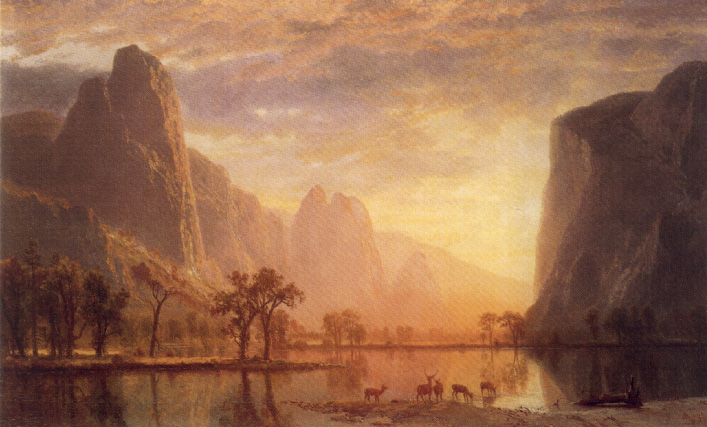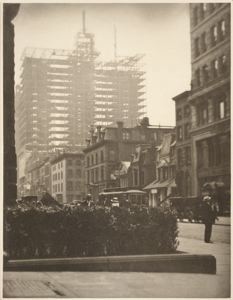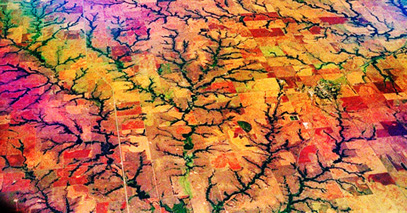

Lewis Mumford,
The Materialist Values in America's Cultural Heritage 
“Western society has accepted as unquestionable a technological imperative that is quite as arbitrary as the most primitive taboo: not merely the duty to foster invention and constantly to create technological novelties, but equally the duty to surrender to these novelties unconditionally, just because they are offered, without respect to their human consequences.”
Emerson, Nature, Emerson II, Olmsted, Siry III, Worster, Merchant, Leopold II, Egan, Rome, Technics and . . .
Mumford argues that there are more important values to nourish as he explains & examines the origins of landscape renewal from the 1870s to the 1890s
Albert Bierstadt, Yosemite Valley deer, Rocky Mountain School.
1. what land, nature, and alteration mean in terms of America and land realism.
2. the motives for a profound transformation in attitudes.
3. the "fountainhead" of the Conservation Movement -- George Perkins Marsh, Man and Nature (1864).
influence of land
state of savagery ( he misread this )
the bridge, the garden, the plowed field, the city,
"the civilization has some prospect of endurance. "
p. 26
"to reduce it to an orderly pattern for use."
Three classes of, despite many forms, of land alteration are:
- agricultural land
- city or cityscape
- "the works of engineering."
Those who saw the reality in renewing the land
"What is a beautiful city with bad drains, or a fine concrete highway in a barren landscape?"
p. 27.
"At worst, it still left the landscape clear; at its best, it gave the land comeliness."
p. 27
"which railroads nosed with grime."
p. 28
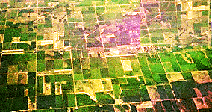 "Rivers filled with refuse, inimical to fish and vegetation, flowed past cities covered wit soot, which added to industrial pollution of the streams by thus wasting, instead of utilizing for fertilizer, their human excrement."
"Rivers filled with refuse, inimical to fish and vegetation, flowed past cities covered wit soot, which added to industrial pollution of the streams by thus wasting, instead of utilizing for fertilizer, their human excrement."
p. 28.
''Mountain sides, first denuded of trees, lost their soil to the local torrents of spring that captured the run-off of the winter snows, now no longer retained and slowly seeping into the soil."
"But this assault on the landscape was not confined to the industrial city: a parallel ruin went on in the countryside."
II.
Millions of acres of arable land were thrown open..."
New settlers, "their impulse was to pluck ravenously..."
p. 28.
"single-crop farming ...a method unsound economically..."
pp. 28-29
"depletion of the soil, the extirpation of wild life, the upsetting of the natural balance of organisms."
"Nathaniel Shaler tells in his autobiography how as late as the middle nineteenth century in Kentucky there was no systematic rotation or manuring, while as a result of timber-mining one half of the arable soil of Northern Kentucky became unremunerative to plough agriculture."
p. 29.
"Land-hunger is one thing, and love of the soil is another. It is scarcely an exaggeration to say that it was only in the Brown Decades that the second attitude began to replace the first."
p. 29.
"The concern for the soil of America..."
"one of the genuine marks"
Nathaniel S. Shaler, John Muir, Frederick Law Olmsted, Henry Thoreau, John Burroughs, George P. Marsh, were leaders in this shift in attitudes.
"bad farming and general desecration of wilderness"
p. 29
"On the contrary, the new sense of land was scientific and realistic."
"Naturalists, geographers and landscape planners."
p. 29.
- soils as natural capital that accrue (builds-up) over time.
- water as a common property to be used to promote the public good.
- forests as watershed required to protect urban and commercial livelihoods.
- fisheries as a public trust to be protected, restored, conserved.
- wildlife as internationally protected natural assets.
- ecology as a science of parts and wholes seen in relation to climate.
- public health viewed as a civic responsibility to promote urban welfare.
- parks as necessary investments in social well being and personal health.
- river and harbor improvements to compensate for deforestation.
- Henry George and the unearned increment: land as a social commodity.
Far western, high plains where settlement patterns give way to arid lands.
Restoration of disturbed harmonies
Geographical regeneration, Marsh's call for investing in restoring the water and landscape.
Urban parks, drainage, and sanitation, Frederick Law Olmsted Sr.
Regional plan for the Arid Regions, John Wesley Powell's vision of the far west.
The renewal of agricultural lands, was the scientifically informed vision of Nathaniel Shaler.
The necessity of preserving grand scenery, was at once the transcendent and scientific realization of John Muir and the men and women who founded the Sierra club in 1892.
The legacy of the post Civil War American visionaries was:
W. J. McGee saw the role of comprehensive river management.
Gifford Pinchot saw the importance of sustained yield forestry as a government duty.
Theodore Roosevelt saw in wildlife the embodiment of the national character.
George Perkins Marsh, therefore was the "fountainhead of the Conservation movement," according to Mumford.
Lewis Mumford wrote Technics and Civilization in 1934.
"To understand the dominating role played by technics in modern civilization….one must explain the culture that was ready to use them and profit by them so extensively."
"Technics and civilization as a whole are the result of human choices and aptitudes and strivings….The machine itself makes no demands and holds out no promises: it is the human spirit that makes demands and keeps promises. In order to reconquer the machine and subdue it to human purposes, one must first understand it and assimilate it. So far, we have embraced the machine without fully understanding it, or, like the weaker romantics, we have rejected the machine without first seeing how much of it we could intelligently assimilate."

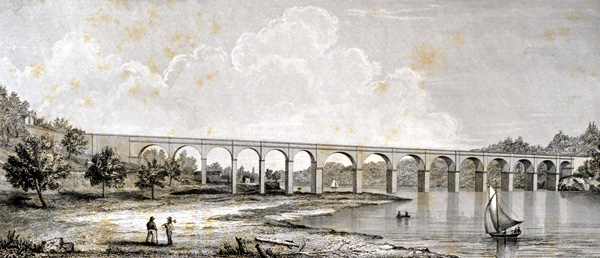
The Croton Aqueduct at the Harlem River from
Tower, F. B.
Illustrations of the Croton Aqueduct. New York and London: Wiley and Putnam, 1843.
The Croton Aqueduct was completed in 1842, and was one of the first successful large-scale engineering projects in the United States. The Croton aqueduct brought water to Manhattan from the Croton River Dam, forty miles away. It involved the building of a dam, 6 tunnels, 114 culverts, bridges over several valleys, and a major bridge over the Harlem river. The advantage of the New York system is that the water has such a good head that no further power is needed for distribution.
The Linda Hall Library, Kansas City, Mo.
In light of the international significance of Mumford's writings, the Library of Congress in Washington, D.C., has designated an impressive auditorium as the Lewis Mumford Room. The general public is allowed to attend lectures and symposia held in this room on the sixth floor of the library's newest structure, the James Madison Memorial Building.
Visit the Mumford personal Library, virtually yours.
Preservation diverges from Conservation as protection.
search site
Emerson| Merchant | Worster | Cronin | Reisner | Jackson | Siry | Leopold | Diamond | Williams | Austin | Mumford | Marx
society
Siry II, Worster, Merchant, Emerson II, Olmsted, Mumford II, Egan, Rome
-
frontier's landscape heritage, J. V. Siry.
-
Donald Worster, as a model of an environmental historian
transformation of the Mississippi Delta, due to river engineering.
revised: January 18, 2015 from October 8, 2007.


